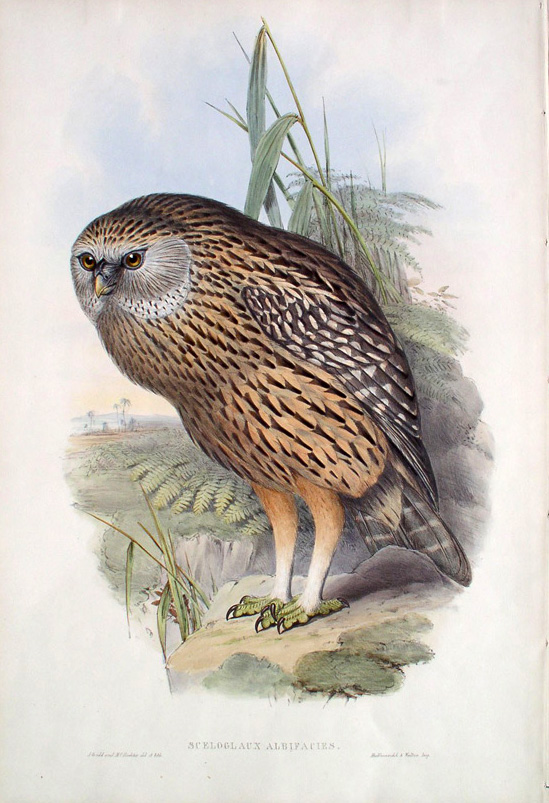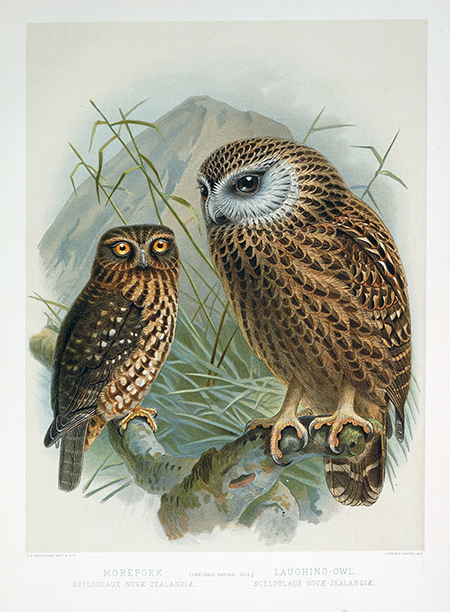


From John Gould's Birds of Australia, 1840–48.
Thomas Henry Potts, described by the ornithologist W. R. B. Oliver as one of the truest naturalists New Zealand has had the good fortune to possess, arrived in New Zealand in 1853 and was one of the few people to have been able to closely observe and describe Whekau, the laughing owl, before it plunged to extinction.
He described the call of Whekau, the laughing owl, as a loud cry made up of a series of dismal shrieks frequently repeated. It is this weird cry which earned for it the name, “laughing owl”. Others described the call as a high pitched chattering. This outburst was only heard when the birds were on the wing and generally on dark and drizzly nights or immediately preceding rain.
The laughing owl belongs to a genus found only in New Zealand and has been estimated to have been in New Zealand for at least a million years and possibly as long as 25 million years.
The laughing owl was, as far as is known, a bird of open country rather than of the forest. It was found in rocky places on the Southern Alps and the downs of Canterbury and Otago. Its home was in rocky crevices and caves, often narrow fissures in limestone rocks where both birds and eggs were only with difficulty obtained.
However, the famous ethnologist, Elsdon Best reported in his book Forest Lore of the Maori that the Whekau or Hakoke was known to the Tuhoi people in the Te Ureweras in the North Island. They informed him that the laughing or rock owl had disappeared after the coming of the Europeans but was said to have lived in holes in cliffs of the higher ranges. Some of the older members of the tribe could point out to him certain pari Hakoke, Hakoke cliffs, formerly frequented by these rock owls.
The North Island and South Island birds have been described as sub species.
One of the earliest collectors of birds in New Zealand was a Percy Earl who forwarded specimens of the laughing owl to the British Museum where they were reported on and published in 1845. Although the species was then fairly abundant, few specimens were collected after this and within forty years of its discovery it had practically disappeared, says Oliver.
The birds began breeding in September or October when nests of dried grass were prepared on bare ground, in rocky ledges or under boulders. Two white eggs just under 5cm were laid and incubation took 25 days. It is not known how long chicks spent in the nest but were fed on worms, according to Oliver.
The bird had much the same reddish brown plumage as the morepork but was much larger and with a white face. From the castings found in its habitat, it ate lizards, insects and small birds. From all accounts it was a ground feeder and had developed long sturdy legs for chasing prey on foot.
The introduction of mustelids for the killing of rabbits is believed to have contributed to its disappearance. The last specimen recorded was found dead at Blue Cliffs in Canterbury in 1914. There have been unconfirmed reports of laughing owls since then, mainly from Fiordland and some from the North Island but no specimens. Brian Parkinson in his book, The Wandering Naturalist, reports of a laughing owl in the Pakahi near Opotiki in the 1940s.
The other major source of information comes from Buller who in turn was informed by a Mr W.W. Smith who managed to breed the owl in captivity and sent Buller “several fine specimens of the bird, together with the eggs and a newly hatched chick” as well as “many letters from him.”
“February 8, 1882. In compliance with your request I have much pleasure in writing a short account of my experience in trying to breed the laughing owl. The drawing of the bird made a great impression on me when I saw it for the first time in your ‘Birds of New Zealand’, and since then I have been searching over five years, trying to procure a specimen.
“I first heard the laughing owl on a very dark, damp night; I found the birds in fissures of the limestone rocks at this place (Albury, near Timaru), but they are certainly very difficult to find. I first discovered that they were about the rocks by finding several fresh pellets, and being anxious to secure a specimen, I procured long wires and felt in the crevices, but with no good results. I, however, discovered a plan which proved successful. I collected a quantity of dry tussock grass and burned it in the crevices, filling them with smoke. After trying a few crannies, I found the hiding-place of one, and after starting the grass, I soon heard him sniffing. I withdrew the burning grass, and when the smoke had cleared away, he walked quietly out, and I secured him. I obtained four birds by this means.
“(The first male) was in beautiful plumage, with the facial disk grey, shading off to white on the outer edges. I remarked that the eyes were conspicuously large, and the iris bright hazel. From the blunted condition of its claws it was evidently a fully matured bird, and to all appearances a male. During the first night of his incarceration he remained perfectly quiet, and refused to take any food. On the following night he moved restlessly about his cage, and once in the evening uttered a loud hailing call, as if wishing to communicate with an absent mate.
“I explained in a former letter how very tame they became in a short while after being captured. I also mentioned their call, which varies considerably during the year. When I captured the second pair (male and female) their call for a long time, in waking in the evening, was, as formerly stated, precisely the same as two men “cooeying” to each other from a distance. The voice of the male is much harsher and stronger than the female, and he is also a much larger and stronger bird.
“During the period of hatching he is very attentive in supplying his mate with food, as no sooner had the food been put into the large apartment of their house, than he would regularly carry every morsel into the dark recess; I may here correct a mistake which I made in writing to you on a former occasion. I stated that “the male sits by day, the female by night”. I only saw the male twice on the eggs, and it was at this time I wrote the letter; but I certainly was mistaken, as the female performs most of three duty of hatching. I also ascertained the difference of the sexes by separating them at night until the second egg was laid. The females are much shyer and more timid than the males, as they hide themselves on hearing the least noise...
“I supplied them with many different articles of food, such as beetles, lizards, mice, rats, rabbits, and mutton, of all of which they partook freely; but they have the greatest preference for young or half–grown rats. They are very slow and clumsy in capturing living prey, but their want of proper exercise and freedom may account for this; it may be otherwise in their wild state.
“The breeding season may be said to extend over September and October. I found the bird mentioned in my last letter sitting on an egg on the 25th September; but it must have been laid about the beginning of the month, as it contained the chick I sent you. I discovered the bird by reaching a long stick with a lighted taper into the crevice. My captives laid on the 23rd, 27th, and 29 September, and again on the 20th and 22nd October. The birds were very restless and noisy for a fortnight before nesting. They began to moult in December, and are not yet (February 8) in full plumage. When casting their feathers they have a very curious appearance, as they become almost naked.”

| Taxonomy | |
|---|---|
| Kingdom: | Animalia |
| Phylum: | Chordata |
| Class: | Aves |
| Order: | Strigiformes |
| Family: | Strigidae |
| Genera: | Sceloglaux |
| Species: | albifacies |
| Sub Species: | rufifacies, albifacies |
Hakoke, rock owl
Endemic bird
38 cm., 600 g., reddish brown plumage streaked with brown, white face.
Extinct

From Walter Lawry Buller's, Birds of New Zealand, 1888. (second ed.)
Gould, John, Birds of Australia, 1840–48.
Buller, Walter Lawry, Birds of New Zealand, 1888. (Second Edition)
Heather, B., & Robertson, H., Field Guide to the Birds of New Zealand, 2000.
Oliver, W.R.B. New Zealand Birds, 1955.
Sunday, 3 September, 2023; ver2023v1